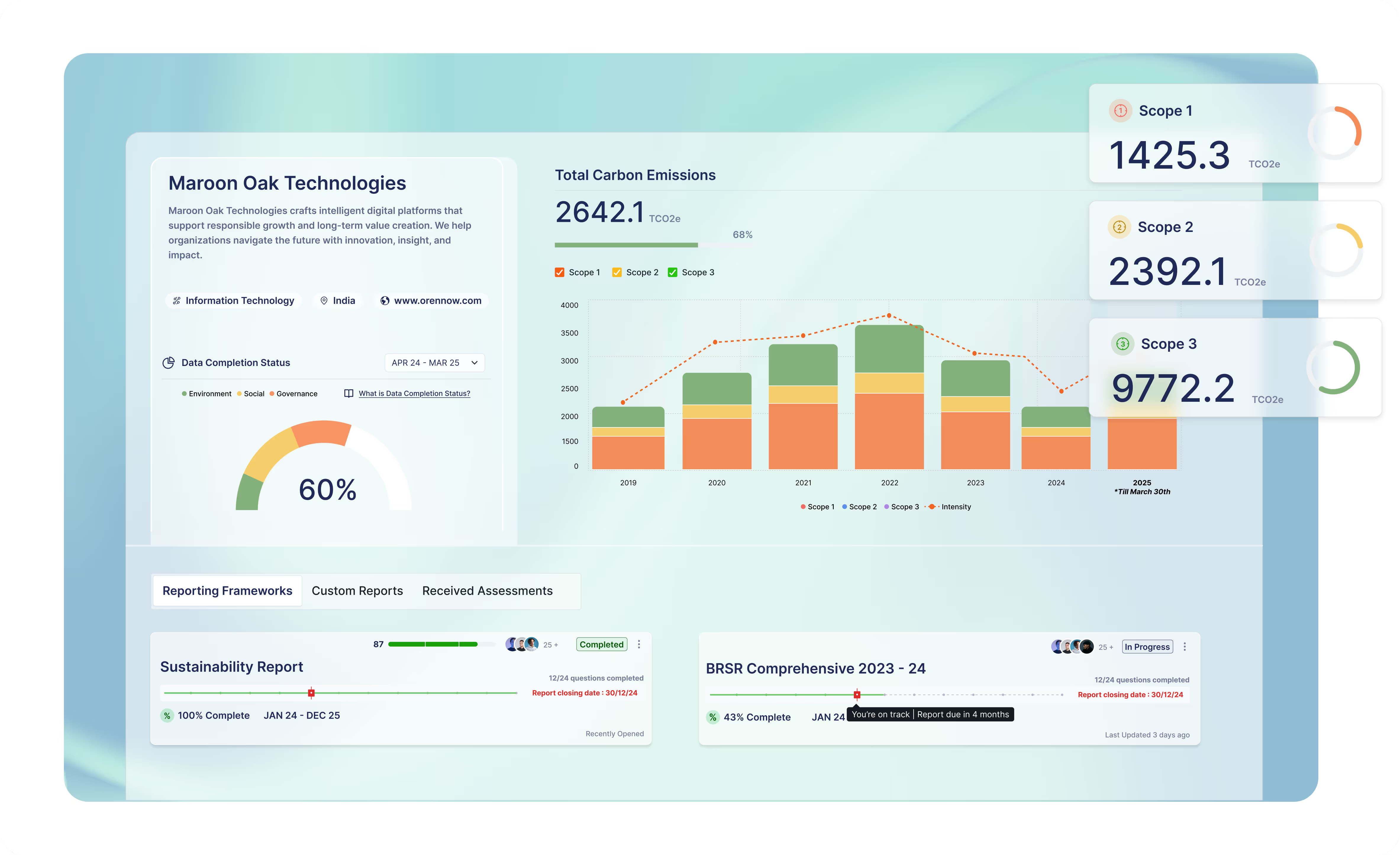How to Identify & Measure the Right ESG Metrics for Your Company

An Introduction to ESG Metrics
Environmental, Social, and Governance or “ESG” metrics are the tools offering insights into organisations’ performance on environmental, social, and governance issues. As companies track financial indicators like revenue or profit, ESG metrics provide a structured way to assess non-financial impacts.
A universal global standard for ESG metrics does not exist. Thus, the definitions and reporting expectations continue to evolve. Institutions like the World Economic Forum are working toward developing a universal standard. Yet, ESG metrics have become important for investors, regulators and stakeholders owing to their capability to evaluate the risks and opportunities specific to sustainability.
Importance of ESG Metrics
ESG metrics offer a comprehensive understanding of a company's resilience, sustainability, and future growth prospects. Its importance can be further listed as follows:
- Improves materiality assessment
- Strengthens stakeholder engagement and trust
- Enhances total tax contributions and financial transparency
- Improves ethical labour practices
Major Parameters to Measure ESG Metrics
ESG performance is commonly assessed using a set of parameters across three core pillars: Environmental, Social, and Governance.
- Environmental metrics evaluate how a company manages its ecological footprint. Examples include:
- Greenhouse Gas (GHG) Emissions
- Carbon Footprint
- Social metrics assess how a company manages its impact on people, including employees, communities and customers. Examples include:
- Product Safety & Quality
- Customer Satisfaction & Privacy
- Governance metrics evaluate how a company is directed and controlled through ethical practices, board oversight and transparent decision-making. Examples include:
- Executive Compensation & Incentives
- Anti-Corruption & Transparency
These parameters are evaluated using two types of ESG metrics, quantitative and qualitative, stated as follows:
- Quantitative metrics: These are numerical measures that show a company’s performance using hard data. An example is recycling rates.
- Qualitative metrics: They describe policies, practices and processes that reflect a company’s approach to sustainability. An example is the company’s human rights policy.
How Leading Companies Measure ESG Metrics to Drive Performance
The companies measure ESG metrics through a structured and data-driven approach to understand current performance and set meaningful sustainability goals. The key steps to measure ESG metrics are stated as follows:
Step 1: Identify Priority Areas
Determine the most relevant ESG themes as per the stakeholder expectations and regulatory requirements. Prioritising material ESG issues ensures alignment with long-term value creation and risk management.
Step 2: Gather Data and Information
Collect internal documents, existing KPIs, policy records, carbon footprint figures and any other available operational data. Ensure to identify the key ESG performance metrics and disclosure frameworks that align with your company’s strategic objectives and regulatory requirements.
Step 3: Engage Stakeholders
Conduct interviews or surveys with HR teams, suppliers, facility managers and community representatives. It adds context to the quantitative data.
Step 4: Analyse and Set Goals
Review the findings to identify strengths, gaps and improvement areas. Set SMART goals that guide long-term ESG strategy and performance tracking. Utilise globally recognised standards such as GRI, SASB, or TCFD to measure and report ESG performance effectively.
ESG Metrics Examples: A Strategic Lens for Decision Makers
ESG metrics serve as a strategic tool for decision-makers by helping compare ESG performance, supporting informed policy-making, stress analysis, guiding decision-making and much more.
Here are the ESG metric examples showing how companies make strategic use of the specific metrics to drive decisions:
ESG Governance Metrics: Governance Insights for the Board
ESG governance metrics provide insights about the quality of leadership, the ethical culture of the company and risk management. These help assess alignment with stakeholder expectations and long-term sustainability.
Key ESG governance metrics that help gain insights for board members include:
- Board composition and diversity
- Ethics and accountability
- Executive compensation
- Shareholder rights and transparency
- Risk management and internal controls
ESG Standards Offering Specific Metrics: Navigating Compliance and Strategy
Decision-makers rely on following established ESG standards to identify reliable, comparable and industry-relevant metrics:
1. Global Reporting Initiative (GRI)
GRI is an independent, international, and non-governmental organisation that provides a comprehensive and globally recognised framework. Organisations use this framework to report their impacts on the economy, environment and society. The GRI Standards offer disclosures and performance indicators organised into Universal, Sector and Topic Standards.
2. Sustainability Accounting Standards Board (SASB)
SASB provides industry-specific ESG metrics that help companies identify, manage and report sustainability risks and opportunities. These encompass the ones that could affect organisations’ financial performance and long-term value. SASB identifies industry-specific performance measures or metrics for 77 industries.
3. Corporate Sustainability Reporting Directive (CSRD)
The CSRD is an EU regulatory directive designed to enhance corporate sustainability disclosures. It helps decision-makers to identify and assess material ESG risks, integrate sustainability into the business model, track metrics, identify areas for improvement and much more.
4. Business Responsibility and Sustainability Reporting (BRSR)
In India, the BRSR framework is a standardised reporting format introduced by the Securities and Exchange Board of India (SEBI) to help listed companies disclose their ESG metrics. It is a key tool for companies to communicate their sustainability initiatives and impacts.
Challenges & Pitfalls in ESG Metrics
Working on ESG metrics is associated with the following challenges and pitfalls:
- Data-related challenges: Difficulty in collecting, managing and ensuring the accuracy of ESG-related data. It includes scope 3 emissions, inconsistent metrics, poor data quality and fragmentation.
- Reporting and standardisation pitfalls: Issues with selecting, interpreting and complying with evolving ESG frameworks. It includes overstatement of results, framework confusion and the requirement for dedicated resources.
- Operational and governance issues: Internal organisational barriers that hinder effective ESG implementation. It involves poor internal controls and resource shortages.
Leveraging ESG Management Software for Executive Reporting and Insights
With voluminous data, challenging reporting standards and much more, technology can come to the rescue in easing the task and ensuring quality. Here is how ESG management software contributes to executive reporting and insights:
- Improves accuracy and efficiency by automating the data collection.
- Offers enhanced insights and supports decision-making by integrating data across ESG factors to provide details about ESG performance.
- Increases transparency and compliance by facilitating communication with investors, customers and regulators.
Conclusion
Identifying and measuring the right ESG metrics enables organisations to understand their real impact, strengthen transparency and build long-term value. Companies can further benefit from ESG metrics by selecting material parameters, engaging stakeholders and using globally recognised standards. Incorporating the technology eases reporting the metrics and gaining relevant insights for strategic decision-making.
FAQs
1. What makes a good ESG metric for executives and boards?
Good ESG metrics for executives and boards are defined to be material, measurable, and directly linked to a company’s strategy, goals, and executive compensation. It should provide clear quantitative and qualitative insights that support informed decisions and long-term value creation.
2. How often should ESG metrics be reviewed by the board?
The board should at least annually review the ESG metrics. However, a quarterly review is recommended to keep up with rapidly evolving ESG guidelines.
3. What is the difference between ESG metrics and ESG KPIs?
ESG metrics provide raw data on a company’s environmental, social, and governance performance. The ESG KPIs are the specific and strategic indicators selected from those metrics to track progress against set goals and priorities.
4. How do ESG metrics relate to ESG ratings and scores?
ESG metrics provide data about the company’s sustainability performance. The ESG ratings and scores are external evaluations based on the data. Ratings agencies analyse reported metrics, apply their own methodologies and assign scores. They offer insights into overall ESG risk, readiness and performance compared to peers.
Latest Blog Posts
Dive into our blog for insights on making your organization more sustainable.
Sustainability Simplified
Wherever you are in your sustainability journey, we help you advance with confidence.
Schedule a Call



.avif)

